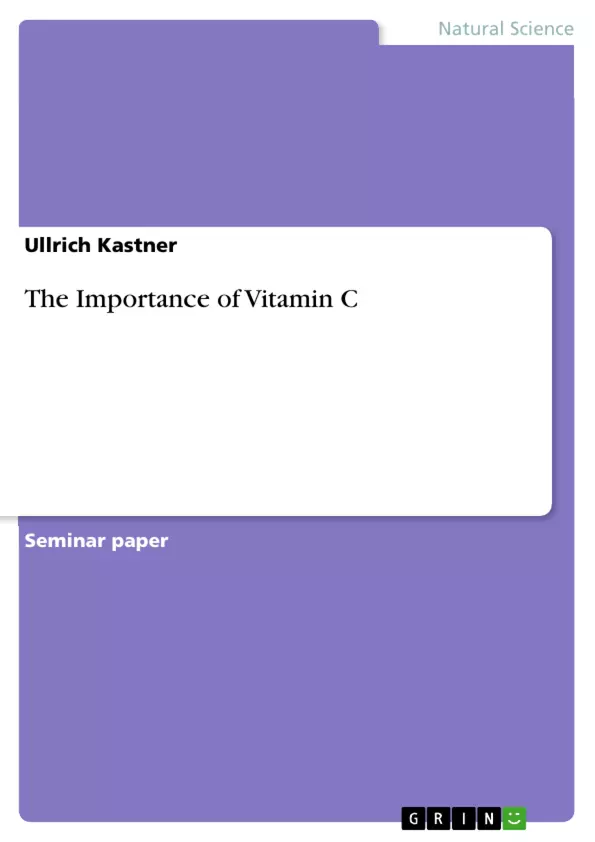The discovery of ascorbic acid, better known as Vitamin C in1928 by the Hungarian Dr. Szent-Gyorgyi, a later Nobel Prize winner, was one of the biggest achievements in the biochemical area. It was without doubt a huge step for the improvement of the human health and well-being. With that discovery however a strong debate started around that important water-soluble vitamin. Another famous scientist, Dr. Linus Pauling proposed in 1970 that the daily intake of Vitamin C needs to be much higher than the officially recommended daily intake of 60mg per day. In his books, Pauling claims that mega doses of Vitamin C can treat the common cold efficiently. This arose a big controversy between scientists in the last years. But what is Vitamin C, what is its function in the human body, and can it really improve our health? Is it really a universal medicine or just another “usual” vitamin? Certain is, that Vitamin C is a very important nutrient, which the human body has to obtain from outside sources; this is different to most animals, except guinea pigs, which can produce ascorbic acid in their livers from glucose. If we don’t get enough Vitamin C, it can cause severe damage to our bodies. Therefore we must ensure, that we obtain enough of it from our diet.
Inhaltsverzeichnis (Table of Contents)
- I. INTRODUCTION
- II. SOURCES
- A. Vegetables
- B. Fruits
- C. Others
- III. CHEMICAL STRUCTURE
- IV. FUNCTIONS
- A. Formation of Collagen
- B. Antitoxin
- C. Immune System
- D. Others
- V. USES
- A. Common Cold
- B. Cancer
- C. Cardiovascular Health
- D. Others
- VI. DEFICIENCY AND TOXICITY
- A. Scurvy
- B. Side effects
- VII. REQUIREMENTS
- VIII. CONCLUSION
- IX. BIBLIOGRAPHY
Zielsetzung und Themenschwerpunkte (Objectives and Key Themes)
This text aims to provide a comprehensive overview of Vitamin C, its importance in the human body, and its potential health benefits. The text explores the history of Vitamin C research, including the discovery of its chemical structure and its function as a vital nutrient.
- The importance of Vitamin C for human health and well-being.
- The role of Vitamin C in various bodily functions, including collagen formation and immune system stimulation.
- The potential benefits of Vitamin C supplementation, including its role as an antitoxin and its ability to combat various diseases.
- The sources of Vitamin C, including its presence in fruits, vegetables, and other food sources.
- The potential risks associated with Vitamin C deficiency and toxicity.
Zusammenfassung der Kapitel (Chapter Summaries)
The text begins with an introduction that explores the history of Vitamin C research and highlights the ongoing debate regarding its importance and optimal intake. The text then delves into the sources of Vitamin C, outlining its presence in various fruits, vegetables, and other food sources.
The text further explores the chemical structure of Vitamin C and its stability in different conditions, including cooking. This chapter includes relevant figures and tables to illustrate the effects of cooking on Vitamin C content.
The text then discusses the functions of Vitamin C in the human body, focusing on its role in collagen formation, its antitoxin properties, and its impact on the immune system.
The text also explores various uses of Vitamin C, including its potential role in preventing and treating common cold, cancer, and cardiovascular diseases.
Finally, the text examines the potential risks associated with Vitamin C deficiency and toxicity, including the condition known as scurvy and the possible side effects of excessive Vitamin C intake.
Schlüsselwörter (Keywords)
This text focuses on the vital nutrient Vitamin C, also known as ascorbic acid, its chemical structure, its importance in human health, and its potential benefits. Key topics include collagen formation, antitoxin properties, immune system stimulation, and the potential for Vitamin C supplementation to address various health concerns. The text explores the sources of Vitamin C and the potential risks associated with deficiency and toxicity.
- Quote paper
- Ullrich Kastner (Author), 2001, The Importance of Vitamin C, Munich, GRIN Verlag, https://www.grin.com/document/13723



